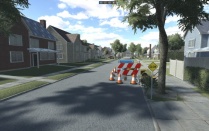Driving Anxiety and Visual Attention in Young Drivers:
A VR Eye-Tracking Study
By: Phoebe Schrag, North Carolina State University
Advisor: Irinia Benedyk, PhD, Department of CSEE, University at Buffalo
Advisor: Gongda Yu, PhD, Department of CSEE, University at Buffalo
Project Objectives
• Do anxious and non-anxious young drivers differ in their self-reported stress, confusion, safety, and scenario comfort during simulated drives?
• Does a single positive affirmation influence stress, confusion, and safety ratings differently for anxious vs. non-anxious drivers?
• Why it matters: Young drivers are particularly vulnerable to crash risk; understanding how anxiety and affirmations influence perception can inform interventions that promote safer, more confident driving.
Data and Results
• Participants: 31 licensed young adult drivers (18–25), grouped by self-reported driving anxiety.
• Instruments: VR driving simulator with integrated eye-tracking.
• Findings: Anxious drivers showed significantly lower saccade counts during high-demand scenarios (e.g., pedestrian crossing), suggesting narrowed visual scanning.
• Affirmation effect: After a positive self-affirmation, saccade counts increased in the anxious group, indicating improved attentional flexibility.
Significance
• Driving anxiety can impair visual scanning, reducing a young driver’s ability to detect hazards.
• Self-affirmation may offer a simple, low-cost way to improve attention and reduce risk in anxious drivers.
• Next steps: Explore long-term effects of affirmation and test in real-world or on-road driving settings.
Publication or Conference
Paper to be submitted to TRB (Transportation Research Board) for conference
------------------------------------------------------------------------------------------------
Center for Geological and Climate Hazards
Interdisciplinary Research Experience for Undergraduates in Atmospheric and Geological Hazards

Example of a simulated static work zone scenario presented during the driving task.